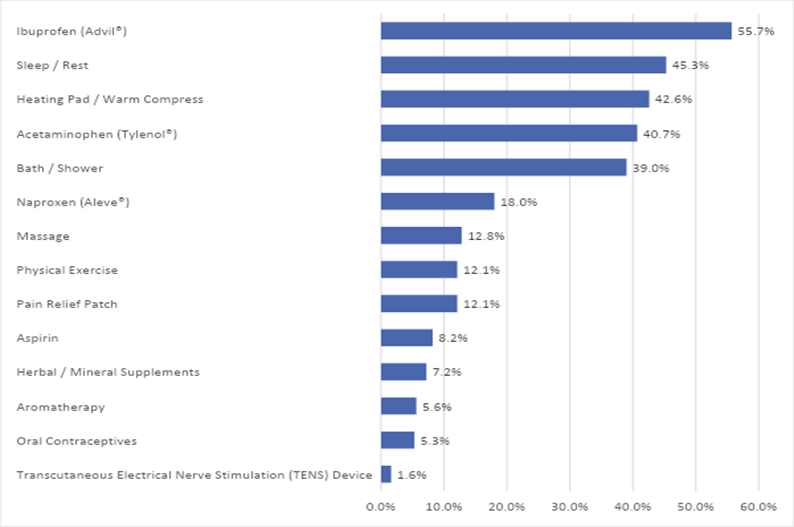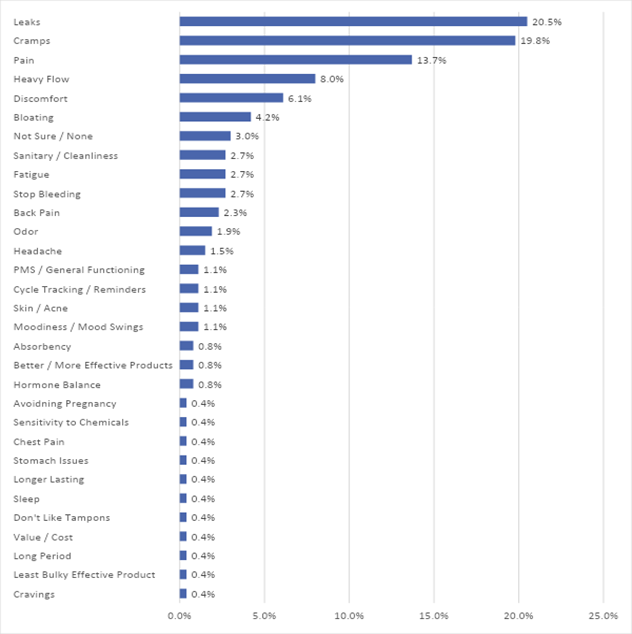Insights Into Menstrual Pain Management: Results from A Quality Improvement Survey of American Women
Margo S Harrison*
Wave Bye Inc, 275 S Dahlia St, Denver CO, 80246, United States
*Corresponding author: Margo S Harrison, Wave Bye Inc, 275 S Dahlia St, Denver CO, 80246 United States.
Received: 02 February 2024; Accepted: 12 February 2024; Published: 19 February 2024
Article Information
Citation: Margo S Harrison. Insights Into Menstrual Pain Management: Results from A Quality Improvement Survey of American Women. Journal of Women’s Health and Development 7 (2024): 06-09.
DOI: 10.26502/fjwhd.2644-288400114
View / Download Pdf Share at FacebookAbstract
Objective: The objective of our quality improvement survey was to use consumer feedback about menstrual pain to improve business practices.
Methods: All de-identified data was collected through an online survey platform called Pollfish and as defined by HIPAA regulations, no personal health information was collected.
Results: 305 women aged 18 - 54+ were surveyed. Ibuprofen (used by 56% of respondents) was the leading pain management technique employed; respondents were asked to select all management techniques that applied. Three of four next most common methods of period pain management were non-medical, including sleep/rest (45%), heating pad/warm compress (43%), and taking a bath/shower (39%). When women were asked what problem they were trying to solve with these interventions, three of the top six symptoms had to do with pain (cramps, 20%; pain, 14%; discomfort, 6%).
Conclusion: Women seek medical and non-medical interventions for period pain management, primarily to solve the problem of pain but also bloating, heavy flow, and leaks.
Keywords
<p>Menstrual pain; Dysmenorrhea; Heavy flow; Bloating; Period pain management</p>
Article Details
Introduction
Primary dysmenorrhea, or menstrual pain, is highly prevalent, affecting up to 95% of women [1]. It is often poorly treated as women consider it an inevitable aspect of their menstrual cycle [1]. The impact of menstrual pain is direct and significant, affecting academic, social, and professional routines [2]. Menstruation is a known contributor to significant productivity loss [3]. Generating novel approaches and products to change this menstrual experience are essential. Wave Bye Inc (WBI) specializes in the development of over-the-counter medications and dietary supplements tailored to address and alleviate menstrual pain and associated symptoms. Our commitment to enhancing consumer experiences led us to conduct a quality improvement survey, which was not driven by specific hypotheses but is integral to understand how our products should eventually be implemented, tested, and assessed in terms of effectiveness. It is important to note that this work, although valuable for our internal strategy, does not constitute formal research and cannot be extrapolated for generalizable knowledge.
Material and Methods
In this analysis, we share the outcomes of a quality improvement initiative with the same overarching objective mentioned earlier. It's important to note that the survey conducted does not fall under the classification of research according to DHHS regulations. De-identified data was gathered through the Pollfish online survey platform, with a strict adherence to HIPAA regulations ensuring that no personal health information was collected. Participation was voluntary, and the intent is for all participants to benefit from the collated quality improvement data, ultimately enhancing WBI products tailored specifically for the menstrual experiences of women. Information on Pollfish recruitment and methodology practices can be accessed here: https://resources.pollfish.com/pollfish-school/how-the-pollfish-methodology-works/. Given the nature of this as a quality improvement exercise, there were no predefined primary or secondary outcomes. Nevertheless, our focus areas encompassed evaluating consumer experiences with menstrual pain and symptom management. This analysis presents the findings derived from a quality improvement survey conducted among women engaged in Pollfish surveys, with analysis performed using STATA software version 15.2 (StataCorp LP, College Station, TX, USA).
Results
Our first question asked the 305 participants what they currently use to manage period pain, and to select all responses that apply to them. The top pain management method was ibuprofen (56%), the second most commonly used intervention was sleep/rest (45%), third was heating pad/warm compresses (43%), 41% of women use acetaminophen, and the fifth most common pain management technique was taking a bath or shower (39%). Results are shown in Figure 1.
Our second question asked women, “When you use period products, what problem are you trying to solve?” The top response was leaks (21%), with the following five answers focused on physical symptoms, including cramps (20%), pain (14%), heavy flow (8%), discomfort (6%), and bloating (4%), as shown in Figure 2.
Discussion
The primary purpose of this survey was to provide valuable insights for informing WBI's business decisions and operations and so consequently, its scope is limited and the results should not be regarded as formal research findings. However, recognizing these limitations, the quality improvement efforts undertaken by WBI through consumer surveys indicate notable aspects. Women, according to the findings, rely on non medical management of menstrual pain as much as over the counter medications. The use of these interventions are primarily to alleviate physical complaints, but also to prevent leakage of menstrual blood. Though literature does exist on menstrual pain management, WBI remains committed to sharing its findings about the goals of that management from the consumer perspective.
Author Contributions
MSH designed the survey, analyzed and interpreted it, and wrote this quality improvement manuscript.
Funding
There was no funding mechanism for this quality improvement work.
Conflict of Interest
The author is the founder, majority equity owner, and CEO of Wave Bye Inc and wishes to disclose this information, though it should not influence the objectivity of this paper and its review, as it was not conducted in reference to any existing products and was performed in order to better understand the menstrual experience of American women. The findings presented in this paper represent the views of the named authors only, and not the views of their institutions or organizations.
Ethical Statement
This work met quality improvement characteristics as determined by the Colorado Multiple Institutional Review Board checklist.
References
- Iacovides S, Avidon I, Baker FC. What we know about primary dysmenorrhea today: a critical review. Hum Reprod Update 21 (2015): 762-778.
- Tataj-Puzyna U, Ilczuk P, Kalita-Kurzynska K, et al. Women’s experiences of dysmenorrhoea - preliminary study. Przeglad Menopauzalny Menopause Rev 20 (2021): 133-139.
- Schoep ME, Adang EMM, Maas JWM, et al. Productivity loss due to menstruation-related symptoms: a nationwide cross-sectional survey among 32 748 women. BMJ Open 9 (2019): e026186.




 Impact Factor: * 3.4
Impact Factor: * 3.4 Acceptance Rate: 78.89%
Acceptance Rate: 78.89%  Time to first decision: 10.4 days
Time to first decision: 10.4 days  Time from article received to acceptance: 2-3 weeks
Time from article received to acceptance: 2-3 weeks 